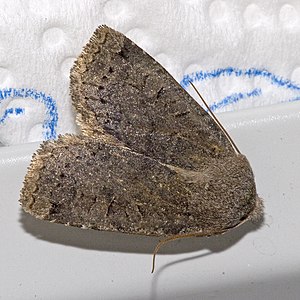Bush winter owl
| Bush winter owl | ||||||||||||
|---|---|---|---|---|---|---|---|---|---|---|---|---|

Bush winter owl ( Conistra ligula ) |
||||||||||||
| Systematics | ||||||||||||
|
||||||||||||
| Scientific name | ||||||||||||
| Conistra ligula | ||||||||||||
| ( Esper , 1791) |
The bush winter owl ( Conistra ligula ), also called steppe bush heather winter owl, is a butterfly ( moth ) from the family of the owl butterflies (Noctuidae). The species flies in autumn, hibernates as a butterfly and is therefore counted among the so-called "winter owls".
features
butterfly
The moth has a wingspan of 30 to 38 millimeters. The animals are very variable in drawing and color, the basic color varies from dark gray to gray-brown to red-brown. Almost black specimens have also been observed. The drawing elements are darker than the basic color, but mostly lined with light; often almost whitish. The wing veins are almost always clearly visible, often darker or lighter dusted. The hem fringes are gray and wavy. The subterminal wavy line is often covered with black dots. The outer transverse line, middle shadow and inner transverse line are sometimes clearly, sometimes almost barely visible. In gray animals the lines are lighter, often almost white. The flaws are also sometimes very clearly demarcated, but sometimes only difficult to see. Usually, however, the kidney defect is more pronounced. Occasionally there are some indistinct light spots on the front or costal margin.
The apex of the fore wing is pointed. The subapical border is straight to slightly concave, but this feature is blurred in heavily flown specimens, as the fringed scales are quickly lost.
The hind wings are monochrome dark gray to brown gray with an indistinct discal spot.
egg
The egg is hemispherical and slightly flattened at the top. It is light reddish in color with a slightly lighter band. The longitudinal lines on the outside are wavy.
Caterpillar
The first caterpillar stages are light green. They later turn reddish brown to slightly reddish brown. There are also greenish-brown shades. The caterpillars have a light, interrupted topline; the lines on the side of the back are also whitish, but somewhat narrower than the line of the back. The side stripes consist of ocher-colored dots, which are accompanied by a slightly darker zone above. The spiracles are black. The underside of the body is light, the head is light brown above, black below.
Occurrence
The species is widespread in western, central and southern Europe. In Western Europe, it is absent in much of Scotland and the western part of Ireland. In Central Europe it is already absent on the German North Sea coast, in Denmark, all of Fennoscandia, the central and northern Baltic states and central and northern Russia. The species is also not found on many Mediterranean islands. In North Africa the species has been found in Morocco, in the east in Turkey, Armenia and northern Iraq.
The bush winter owl prefers semi-open, dry and warm locations in light deciduous forests, bushes (e.g. hawthorn and blackthorn bushes on the edges of forests), grasslands , abandoned vineyards, orchards and gardens. It occurs from the lowlands to around 1000 meters above sea level in the Alps.
Way of life
The bush winter owl forms a generation a year, which flies from the beginning / middle of September to November, and after wintering from the end of February to the beginning of May. The folds are nocturnal, fly to light sources and can be baited . In spring they suckle on blooming pussy willows . The reproduction strategy of the species differs within the distribution area. In the northern Atlantic zone, mating has been observed to occur in autumn. The majority of the overwintering moths are females that lay their eggs in spring. In the more southern and southeastern distribution areas, male and female moths overwinter equally and mate in spring.
The eggs are laid on various deciduous trees. The caterpillars can be found from mid-April to June. They feed on the leaves of oaks ( Quercus ), hawthorns ( Crataegus ) and sloes ( Prunus spinosus ). The following are also mentioned in the literature: willows ( Salix ), clematis ( clematis ), hornbeams ( Carpinus ), ash trees ( Fraxinus ), medlar ( Mespilus ), myrica , pears ( Pyrus ), elms ( Ulmus ), currants ( Ribes ), roses ( Rosa ), dock ( Rumex ), dandelion ( Taraxacum ), birch ( Betula ), maple ( Acer ), linden ( Tilia ) and honeysuckle ( Lonicera ).
Danger
The stocks of the species are declining in the Federal Republic. In some federal states it is considered safe (e.g. Baden-Württemberg), in other federal states it is lost or extinct (Schleswig-Holstein) or threatened with extinction (Mecklenburg-Western Pomerania). However, these two federal states also represent the northern limit of the occurrence in Central Europe.
swell
Individual evidence
- ↑ Günter Ebert (Ed.): The Butterflies of Baden-Württemberg Volume 6, Nachtfalter IV. Ulmer Verlag Stuttgart 1997 (Eulen (Noctuidae) 2nd part), p. 469, ISBN 3-800-13482-9
literature
- Günter Ebert (Ed.): The butterflies of Baden-Württemberg Volume 6, Nachtfalter IV. Ulmer Verlag Stuttgart 1997 (Eulen (Noctuidae) 2nd part), ISBN 3-800-13482-9
- Walter Forster , Theodor A. Wohlfahrt : The butterflies of Central Europe. Volume 4: Owls. (Noctuidae). Franckh'sche Verlagshandlung, Stuttgart 1971, ISBN 3-440-03752-5 .
- Lázló Ronkay, José Luis Yela & Márton Hreblay: Noctuidae Europaeae Volume 5 Hadeninae II. 452 S., Entomological Press, Sorø 2001 ISBN 87-89430-06-9
Web links
- www.lepiforum.de Taxonomy and photos
- Moths and Butterflies of Europe and North Africa (English)
- Ian Kimber: Guide to the moths of Great Britain and Ireland (English)
- Conistra ligula at Fauna Europaea